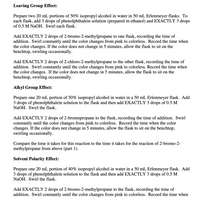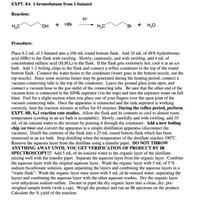
Chemistry
10th Edition
ISBN: 9781305957404
Author: Steven S. Zumdahl, Susan A. Zumdahl, Donald J. DeCoste
Publisher: Cengage Learning
expand_more
expand_more
format_list_bulleted
Question
Can you please TYPE and Draw out the reactions that took place in this experiment. Any change that took place - from a full synthesis to a mere acid/base exchange of protons should be included
* I have included all the instructions to this lab, please read over the prodecure and answer the question abov.

Transcribed Image Text:Leaving Group Effect:
Prepare two 20 mL portions of 50% isopropyl alcohol in water in 50 mL Erlenmeyer flasks. To
each flask, add 3 drops of phenolphthalein solution (prepared in ethanol) and EXACTLY 3 drops
of 0.5 M NAOH. Swirl each flask.
Add EXACTLY 2 drops of 2-bromo-2-methylpropane to one flask, recording the time of
addition. Swirl constantly until the color changes from pink to colorless. Record the time when
the color changes. If the color does not change in 5 minutes, allow the flask to sit on the
benchtop, swirling occasionally.
Add EXACTLY 2 drops of 2-chloro-2-methylpropane to the other flask, recording the time of
addition. Swirl constantly until the color changes from pink to colorless. Record the time when
the color changes. If the color does not change in 5 minutes, allow the flask to sit on the
benchtop, swirling occasionally.
Alkyl Group Effect:
Prepare one 20 mL portion of 50% isopropyl alcohol in water in a 50 mL Erlenmeyer flask. Add
3 drops of phenolphthalein solution to the flask and then add EXACTLY 3 drops of 0.5 M
NaOH. Swirl the flask.
Add EXACTLY 2 drops of 2-bromopropane to the flask, recording the time of addition. Swirl
constantly until the color changes from pink to colorless. Record the time when the color
changes. If the color does not change in 5 minutes, allow the flask to sit on the benchtop,
swirling occasionally.
Compare the time it takes for this reaction to the time it takes for the reaction of 2-bromo-2-
methylpropane from above (part 1).
Solvent Polarity Effect:
Prepare one 20 mL portion of 40% isopropyl alcohol in water in a 50 mL Erlenmeyer flask. Add
3 drops of phenolphthalein solution to the flask and then add EXACTLY 3 drops of 0.5 M
NaOH. Swirl the flask.
Add EXACTLY 2 drops of 2-bromo-2-methylpropane to the flask, recording the time of
addition. Swirl constantly until the color changes from pink to colorless. Record the time when

Transcribed Image Text:EXPT. 8A 1-bromobutane from 1-butanol
Reaction:
H+
H,C
HO.
HBr
+
H,0
Br
Procedure:
Place 6.2 mL of 1-butanol into a 100 mL round bottom flask. Add 10 mL of 48% hydrobromic
acid (HBr) to the flask with swirling. Slowly, cautiously, and with swirling, add 4 mL of
concentrated sulfuric acid (H2SO4) to the flask. If the flask gets extremely hot, cool it in an ice
bath. Add 1-2 boiling chips to the flask and connect a reflux condenser to the top of the round
bottom flask. Connect the water hoses to the condenser (water goes in the bottom nozzle, out the
top nozzle). Since some noxious fumes may be generated during the heating period, connect a
vacuum connecting tube to the top of the condenser. Leave the ground glass joint open,
connect a vacuum hose to the gas outlet of the connecting tube. Be sure that the other end of the
vacuum hose is connected to the SINK aspirator (via the trap) and turn the aspirator water on full
blast. Feel for a slight suction when you place one of your fingers over the open joint of the
vacuum connecting tube. Once the apparatus is connected and the sink aspirator is working
correctly, heat the reaction mixture at reflux for 45 minutes. During the reflux period, perform
EXPT. 8B, SN1 reaction rate studies. Allow the flask and its contents to cool to almost room
temperature (cooling in an ice bath is acceptable). Slowly, carefully and with swirling, add 10
mL of de-ionized water to the mixture by pouring it through the condenser. Add a new boiling
chip (or two) and convert the apparatus to a simple distillation apparatus (disconnect the
vacuum). Distill the contents of the flask into a 25 mL round bottom flask which has been
immersed in an ice bath. Stop distilling when the temperature of the distillate reaches 100°C.
Remove the aqueous layer from the distillate using a transfer pipet. DO NOT THROW
ANYTHING AWAY UNTIL YOU GET VERIFICATION OF PRODUCT BY IR
SPECTROSCOPY!!! Add 5 mL of de-ionized water to the organic layer of the distillate,
mixing well with the transfer pipet. Separate the aqueous layer from the organic layer. Combine
the aqueous layer with the original aqueous layer. Wash the organic layer with 5 mL of 5 %
sodium bicarbonate solution, again separating the layers and combining the aqueous layers in a
"waste flask". Wash the organic layer once more with 5 mL of de-ionized water, separating the
layers and combining the aqueous layer with the other aqueous washes. Dry the organic layer
over anhydrous sodium sulfate. Decant or pipet the dry organic layer into a clean, dry, pre-
weighed sample bottle (with a cap). Weigh the product and run an IR spectrum on the product.
Calculate the % yield of the reaction.
and
Expert Solution
This question has been solved!
Explore an expertly crafted, step-by-step solution for a thorough understanding of key concepts.
Step by stepSolved in 2 steps with 1 images

Knowledge Booster
Learn more about
Need a deep-dive on the concept behind this application? Look no further. Learn more about this topic, chemistry and related others by exploring similar questions and additional content below.Similar questions
- Hello,can you help with with number 1 ,2 and 3 questions please.arrow_forwardWhich of the following typically increase the rate of a reaction? Pick all correct responses. A. Removal of an appropriately designed catalyst B. Addition of an appropriately designed, and chosen, catalyst C. Fluctuation in reaction pressure D. Increase in the initial concentration of the chemical reagents E. Increase in reaction temperaturearrow_forwardwas reading the organic chemical literature and was surprised to read that this structure reacts with good Lewis/attacker nucleophiles rapidly by the SN1 pathway. Why was Prof. surprised by these data? Explain these data using your knowledge of SN1 pathways. Prof. Me xo Me Me OTSarrow_forward
- 1. The carbon radical intermediate that formed from ibuprofen in this experiment is shown below. Draw all resonance structures of the radical intermediate (show electron-pushing arrows). for HOarrow_forward! ( asap within 10 min with mechanism otherwise dislike)arrow_forwardLaboratory Activity Frankenstein - Osmotic Pressure Objective: To determine the effects of concentration of solute on osmotic pressure of solutions Materials: raisins, tomato, salt, water, and containers Procedure: 1. Before you did this activity, make a prediction by drawing pictures of what will happen to the raisins before and after the activity. Before After 2. in a container, dissolve salt in water until no more salt dissolves. Another container will hold pure distilled water. 3. Submerged five raisins in each container. 4. Note the appearance of the raisins. From time to time, inspect how the raisins look, Record your observations. 5. Explain the reason behind why the raisins appear like that when you submerged the raisins in different container.arrow_forward
- Please don't provide handwritten solution.....arrow_forwardOrganic Chemistry 1 Here is the professor's solution to the problem. The assignment has been turned in and the answer key has been shared with the class. So, this is the official answer key. However, I do NOT understand the solution. Please explain the answer in a clear step-by-step fashion to me. Explain the answer provided in the image in a clear fashion and as if I did not know much about organic chemistry.arrow_forwardWrite the dissociation reaction for HS- knowing that it has a Kb value.arrow_forward
arrow_back_ios
arrow_forward_ios
Recommended textbooks for you
 ChemistryChemistryISBN:9781305957404Author:Steven S. Zumdahl, Susan A. Zumdahl, Donald J. DeCostePublisher:Cengage Learning
ChemistryChemistryISBN:9781305957404Author:Steven S. Zumdahl, Susan A. Zumdahl, Donald J. DeCostePublisher:Cengage Learning ChemistryChemistryISBN:9781259911156Author:Raymond Chang Dr., Jason Overby ProfessorPublisher:McGraw-Hill Education
ChemistryChemistryISBN:9781259911156Author:Raymond Chang Dr., Jason Overby ProfessorPublisher:McGraw-Hill Education Principles of Instrumental AnalysisChemistryISBN:9781305577213Author:Douglas A. Skoog, F. James Holler, Stanley R. CrouchPublisher:Cengage Learning
Principles of Instrumental AnalysisChemistryISBN:9781305577213Author:Douglas A. Skoog, F. James Holler, Stanley R. CrouchPublisher:Cengage Learning Organic ChemistryChemistryISBN:9780078021558Author:Janice Gorzynski Smith Dr.Publisher:McGraw-Hill Education
Organic ChemistryChemistryISBN:9780078021558Author:Janice Gorzynski Smith Dr.Publisher:McGraw-Hill Education Chemistry: Principles and ReactionsChemistryISBN:9781305079373Author:William L. Masterton, Cecile N. HurleyPublisher:Cengage Learning
Chemistry: Principles and ReactionsChemistryISBN:9781305079373Author:William L. Masterton, Cecile N. HurleyPublisher:Cengage Learning Elementary Principles of Chemical Processes, Bind...ChemistryISBN:9781118431221Author:Richard M. Felder, Ronald W. Rousseau, Lisa G. BullardPublisher:WILEY
Elementary Principles of Chemical Processes, Bind...ChemistryISBN:9781118431221Author:Richard M. Felder, Ronald W. Rousseau, Lisa G. BullardPublisher:WILEY

Chemistry
Chemistry
ISBN:9781305957404
Author:Steven S. Zumdahl, Susan A. Zumdahl, Donald J. DeCoste
Publisher:Cengage Learning

Chemistry
Chemistry
ISBN:9781259911156
Author:Raymond Chang Dr., Jason Overby Professor
Publisher:McGraw-Hill Education

Principles of Instrumental Analysis
Chemistry
ISBN:9781305577213
Author:Douglas A. Skoog, F. James Holler, Stanley R. Crouch
Publisher:Cengage Learning

Organic Chemistry
Chemistry
ISBN:9780078021558
Author:Janice Gorzynski Smith Dr.
Publisher:McGraw-Hill Education

Chemistry: Principles and Reactions
Chemistry
ISBN:9781305079373
Author:William L. Masterton, Cecile N. Hurley
Publisher:Cengage Learning

Elementary Principles of Chemical Processes, Bind...
Chemistry
ISBN:9781118431221
Author:Richard M. Felder, Ronald W. Rousseau, Lisa G. Bullard
Publisher:WILEY